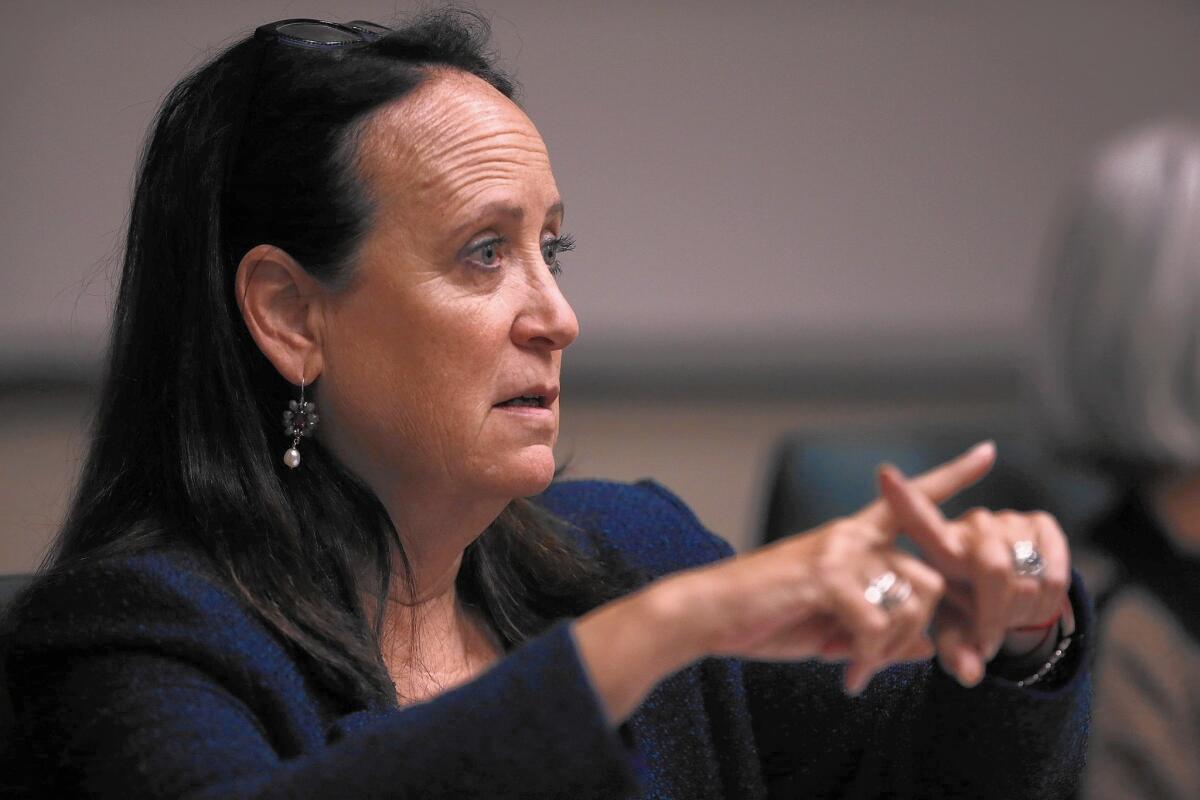Drought hasn’t been all bad—we’ve learned some things too, California water chief says

It was the final Wednesday of a warm, dry February, and here as in much of California it seemed that spring had made an early arrival.
The sky was blue, temperatures mild. Almond and fruit trees were ablaze with blossoms. Along the highways, poppies were in full flower, competing for attention with ubiquitous Caltrans message boards that warned: “Severe drought/Limit Outdoor Watering.”
Indeed, however pleasing in the abstract, the early turn of seasons has been not so welcome to those who keep watch on California water — and, in particular, to the Sacramento official who spent the last year cajoling the state’s urban residents to cut back significantly on their water consumption.
NEWSLETTER: Get the day’s top headlines from Times Editor Davan Maharaj >>
“Crazy-making” is how Felicia Marcus, chair of the state water board and the political face of the ongoing drought, characterized a February in which nature suddenly turned off its taps. “Nervous-making.”
This had been relentlessly ballyhooed as the year of El Niño, and the hope for a drought-busting winter tended to obscure caveats from climate specialists that, with long-term weather prognostication, there never is a sure thing.
December and January storms did bring the Sierra snowpack to somewhere close to normal, but by the end of Feburary it had slipped back to only 83% of average — a “C-minus,” as Marcus put it.
“After what felt like a deluge, and what felt like a massive snowfall, we now find ourselves at about average for this time of year,” she said in an interview. “Obviously, the hot and dry February is disheartening for everyone. It feels weird.”
That said, she is not without hope for what March and April might produce. At the mention of the drought-easing “March Miracle” of 1991, she placed her hands together as if in prayer and lifted her eyes toward the heavens, or at least the ceiling — a human emoji to aptly depict where California stands as it contemplates the possibility of a fifth year of drought.
“We will be grateful for every raindrop and every snowflake that we get,” she said. “We’ll be counting them. But we just can’t know, so we have to cross our fingers. And hope.”
She noted that the state is in better shape than a year ago, when the crucial Sierra snowpack went missing altogether.
NEWSLETTER: Get the day’s top headlines from Times Editor Davan Maharaj >>
Still, without a late-breaking miracle, the wet year has not brought enough relief to fill the major reservoirs, replenish the over-tapped aquifers or allow suburbanites to ditch their shower buckets and turn on the sprinklers full bore.
On the bright side, Marcus can look back on the last year and see any number of advances being made in how Californians capture, use and even think about water — lessons forced by drought, but with longer-term applications as the state grows and climate change alters the water landscape.
For example, that half of all urban water consumption is spent on landscaping seems to have sunk in, as has a greater appreciation for the hardiness of lawn grass. In Northern California at least, lawns that went brown in the summer and fall are now green — following the natural cycle of the foothills.
“It is hard to kill grass,” Marcus said. “And while I don’t think in the long run it’s realistic to think people are going to keep their lawns brown forever, I do think folks have learned they don’t need as much water as they have been dumping on them.… So that is a real ‘aha’ for people.”
Also demonstrated through eight months of mandatory cutbacks is that reducing consumption by nearly 25% is doable — a mark Marcus feared would be unattainable when the order went out.
Marcus grows most animated when discussing a movement underway at many local agencies up and down the state — one aimed toward integrating traditional water delivery with enhanced recycling, storm-water capture, underground storage and the like.
Not the stuff of statues and naming rights, perhaps, but collectively these efforts have the potential to create a new day for California water.
“This is a high-value, low-glamour play,” Marcus said, ticking off multiple efforts underway from the Southland to Santa Clara. It is essential work, she said, if climate change as predicted undermines the Sierra snowpack in the not-so-distant future.
“All of the conflicts we have today are going to seem like a picnic if we don’t change how we use water,” she said. “And that means everything. It means conservation. It means recycling. It means storm-water capture. It means desalination in the appropriate circumstances. And it means more storage, above ground and below.”
In the meantime, there is the looming dry season to address.
Is she worried?
Yes.
“I worry that we are going to be in another year of drought. I am worried about those communities, particularly small rural communities in the Central Valley, that are out of water and need a respite from that.…
“I worry about small farming families that don’t have senior water rights and have to fallow their fields and the citrus growers who don’t have groundwater they can rely on.
“I worry about how those tensions exacerbate nonproductive rhetoric that pits urban versus agriculture, or fish versus farmers, or fish versus people. Or picking on a given crop when what we really need to be doing is embracing an all-of-the-above strategy so we can all get better together, rather than wasting time vilifying a number of very legitimate needs.”
The emergency declaration that allowed mandatory conservation was extended earlier in February, a move that met with some resistance but with each dry day seems a bit more prescient.
The amount of mandated conservation, if any, will not be decided until the end of April, giving nature, and El Niño, a last chance to get busy. If it becomes necessary, Marcus is not worried that Californians, drought fatigue or not, will fail to rise to the moment, again.
“I think folks can do it again if the situation is as dire,” she said. “If it is not as dire, you don’t want to make them do it.”
So for now it is a waiting game.
“Is this rain and snow we have gotten just a punctuation mark in a longer sentence, a longer paragraph, a longer story? Or are we going to get a year or two breather before the next one?”
Only March and April are left to provide an answer.
Twitter: @peterhking
ALSO
Why millennials are staying away from homeownership despite an improving economy
Ku Klux Klan ‘without robes’ makes headlines, but influence fading, anti-hate group says
Ecstasy overdose caused death of UCLA student who went to rave at county fairgrounds
More to Read
Start your day right
Sign up for Essential California for news, features and recommendations from the L.A. Times and beyond in your inbox six days a week.
You may occasionally receive promotional content from the Los Angeles Times.







